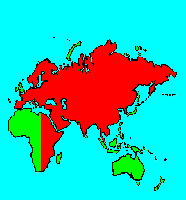SPECIES INFO
Hyaenodon genus was found over most of the Northern Hemisphere and south into eastern Africa. These animals were found from about 50 to 20 million years ago. These animals would remind one of a modern hyena, but the elongated muzzle is not typical of any modern carnivore. They stood upwards of 4 feet high at the shoulder, and were perhaps over 5 feet long excluding their long tails.These animals lived from about 50 to 10 million years ago. Although they certainly remind one of modern carnivores, the evidence suggests that the modern Carnivora did not evolve from this ancient line. These animals had smaller brains than modern carnivores.
The creodonts (Creodonta order) were previously considered part of the Insectivora order, but recent research suggests these animals belong in their own order within the mammals. In appearance and habits these carnivorous animals were in many ways like modern dogs, hyenas, and bears. There have been over 50 different genera described that have been placed into two families: Oxyaenidae and Hyaenodontidae. These animals lived from about 10 to 60 million years ago.
Mammals (Class Mammalia), together with the birds, are among the youngest of the classes of animals. In species count, mammals number about fifty-one hundred, trailing reptiles (approximately fifty-five hundred), fish (approximately eighteen thousand), and birds (approximately eighty-six hundred).
There are three sub-types of mammals:
monotremes, the most primitive:
Develop in reptilian-like eggs and suckle milk emerging
(i.e., spiny anteater, duckbilled platypus)
marsupials
Newborn emerges very underdeveloped and continue to
mature in a pouch on its mother's abdomen (i.e., opossums,
koala, kangaroo)
placental
Embryo develops within the uterus of the female and is
dependent on a placenta for nutrition and waste removal
(i.e., humans, lions, monkeys)
About sixty-five million years ago, the Tertiary era produced thirty-five orders of mammals. Of this number, eighteen have survived to represent Earth's most diversified as well as its most highly developed classification of animals.
Extinction of mammals is fast becoming a serious issue. Duff and Lawson present a list of forty-one extinct species that reached extinction prior to 1800. These forty-one species are not acknowledged in the counts of the various families. Duff and Lawson also present a list of forty-six species including three gazelles, one zebra, one seal, one deer, and one wolf that have probably gone extinct since 1800. These forty-six species are included in the family counts. Science is adding about forty to fifty new species a year to the list. Many of these are the result of divisions of prior species; some are recent discoveries.
Mammals owe their survival to adaptive capabilities that include the ability to exploit whatever sources of food are available to them, as well as their ability to adjust to various climes. Food specialization influenced evolution to such a great extent that the teeth structure can and has been used to provide extensive information on the food needs and various lifestyles of extinct species.
Despite the vast diversity among mammals in terms of size, habitats and adaptations, they share without exception many characteristics such as:
a. body hair
b. mammary glands
c. certain skull characteristics
d. four limbs that permit speed
e. parallel not perpendicular limbs
f. compartmentalized internal organs
g. a four-chambered heart and pulmonary circulation
Backboned Animals (Phylum Chordata) are the most advanced group of animals on earth. These animals are characterized by having a spinal cord or backbone. Most members have a clearly defined brain that controls the organism through a spinal cord. Fish, amphibians, reptiles, birds, and mammals are in this phylum.
Currently, some taxonomists believe that the fish should be divided into two groups (sharks and regular fishes) and that there are some other primitive groups in the phylum such as hagfish or lampreys.
Animal Kingdom contains numerous organisms that feed on other animals or plants. Included in the animal kingdom are the lower marine invertebrates such as sponges and corals, the jointed legged animals such as insects and spiders, and the backboned animals such as fish, amphibians, reptiles, birds, and mammals.

